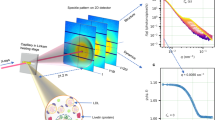Summary
-
(1)
The reaction by which yolk platelets isolated from frog eggs undergo lysis in the presence of low concentrations of calcium ions is described and kinetic data are presented.
-
(2)
A crude yolk precipitate, prepared by salting-in and reprecipitating the material of intact yolk platelets, undergoes the same reaction as do the intact platelets.
-
(3)
Data are presented on the pH dependence and thermal inhibition of the reaction.
-
(4)
The yolk contains a material, perhaps a protein, which catalyzes the lysis reaction. This material is not the soluble product of the reaction, since the kinetics are not those of an autocatalytic process.
-
(5)
A possible mechanism for the reaction is discussed.
Similar content being viewed by others
Literature cited
Heilbrunn, L. V., 1952: An Outline of General Physiology, 3rd ed. Philadelphia.
Hultin, T., 1950: On the Acid formation, breakdown of cytoplasmic inclusions, and increased viscosity inParacentrotus egg homogenates after the addition of calcium. Exp. Cell Res.1, 272–283.
Lundblad, G., 1952: Proteolytic activity in sea-urchin gametes. II. Activity of extracts and homogenates of the egg subjected to different treatments. Arkiv för Kemi4, 537–565.
Gross, P. R., 1951: The lytic action of calcium ions on the pigment granules of theArbacia egg. Biol. Bull.101, 209.
—, 1952: A study of colloidal changes in sea-urchin egg homogenates. Biol. Bull.103, 293.
Höber, R., 1945: Physical Chemistry of Cells and Tissues. Philadelphia, p. 305.
Holtfreter, J., 1946: Experiments on the formed inclusions of the amphibian egg. J. exper. Zool.101, 355–405.
Terry, R. L., 1950: The surface precipitation reaction of the ovarian frog egg. Protoplasma39, 206–221.
Panijel, J., 1950: L'organisation du vitellus dans les œufs d'amphibiens. Biochim. et Biophys. Acta5, 345–357.
Essner, E. S., 1954: The breakdown of isolated yolk granules by cations. Protoplasma43, 79–89.
Mazia, D., and T. Hayashi, 1953: The activity of pepsin-albumin films. Arch. Biochem. and Biophys.43, 424–442.
Author information
Authors and Affiliations
Additional information
This investigation was supported by a research grant from the National Cancer Institute, National Institutes of Health, Public Health service, administered by L. V. Heilbrunn.
National Science Foundation predoctoral research fellow.
The author wishes to thank Dr. L. V. Heilbrunn for his helpful suggestions and criticism.
Rights and permissions
About this article
Cite this article
Gross, P.R. On the mechanism of the yolk-lysis reaction. Protoplasma 43, 416–428 (1954). https://doi.org/10.1007/BF01248279
Received:
Issue Date:
DOI: https://doi.org/10.1007/BF01248279




